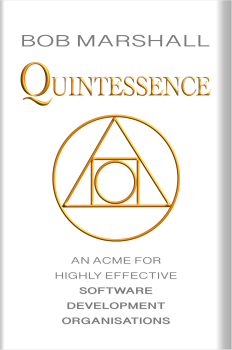Interactive Book: Quintessence – Chapter 19, Structure
Sidecar for Chapter 19 of “Quintessence” (Structure)
Selected ChatGPT Prompts
In this section, we provide 10 heavyweight prompts that will help you explore and understand the concept of Structure, as discussed in the chapter from the book “Quintessence”. These prompts are designed to be useful in facilitating deeper understanding, critical thinking, and active engagement with the topic. To customise the prompts, simply modify them to suit your specific interests or requirements.
- [Purpose] Define “Structure” in the context of organisations.
[Prompt] What does “Structure” mean in the context of an organisation, and how does it impact the effectiveness of its operations? - [Purpose] Understand the concept of fluidity in organisational structure.
[Prompt] Explain the importance of fluidity in organisational structures and discuss the factors that increase and decrease fluidity. - [Purpose] Examine Conway’s Law and Reverse Conway.
[Prompt] What are Conway’s Law and Reverse Conway, and how do they relate to organisational structures and effectiveness? - [Purpose] Explore the idea of self-organising structures.
[Prompt] What are self-organising structures, and why do quintessential organisations believe they are more effective than centrally controlled structures? - [Purpose] Investigate the role of the Advice Process in fluid structures.
[Prompt] What is the Advice Process, and how does it contribute to fluid organisational structures and effectiveness? - [Purpose] Analyse the impact of size on organisational structure.
[Prompt] How do the number of employees and the size of an organisation affect its structure, fluidity, and effectiveness? - [Purpose] Examine the role of informality in fluid structures.
[Prompt] Discuss the importance of informality in creating fluid organisational structures and how it contributes to effectiveness. - [Purpose] Evaluate the concept of multi-skilling in fluid structures.
[Prompt] What is multi-skilling, and how does it influence fluidity and effectiveness in organisational structures? - [Purpose] Investigate the relationship between technology and fluidity.
[Prompt] How do information technology and automation impact fluidity in organisational structures, and what are their potential benefits and drawbacks? - [Purpose] Delve into the importance of self-restructuring across an organisation.
[Prompt] Why is self-restructuring across an entire organisation important for achieving fluidity, and how can it be implemented effectively?
Suggested Learning Path on the Topic of “Structure”
- Understand organisational structure and its impact on effectiveness.
[Prompt] Define organisational structure and explain how it influences the effectiveness of an organisation.
[Exercise] Analyse your organisation’s current structure and identify its strengths and weaknesses. Consider how potential changes to the structure might improve overall effectiveness. - Explore fluidity in organisational structures.
[Prompt] Explain the concept of fluidity in organisational structures and discuss its importance for business agility and effectiveness.
[Exercise] Evaluate your organisation’s current structure for fluidity. Identify areas where increased fluidity might be beneficial and propose strategies for introducing greater fluidity. - Examine the role of distributed decision-making in fluid structures.
[Prompt] Discuss the benefits of distributed decision-making in promoting fluid organisational structures and enhancing effectiveness.
[Exercise] Assess your organisation’s decision-making processes and identify opportunities for distributing decision-making responsibilities. Propose changes that could promote a more fluid structure. - Investigate the impact of informality on fluid structures.
[Prompt] Explain the relationship between informality and fluidity in organisational structures and how it contributes to effectiveness.
[Exercise] Observe your organisation’s level of formality and informality. Identify areas where increased informality might contribute to a more fluid structure, and propose strategies for fostering a more informal environment. - Delve into self-organising structures and their effectiveness.
[Prompt] Describe the concept of self-organising structures and explain why they are considered more effective than centrally controlled structures.
[Exercise] Identify opportunities for introducing self-organising structures within your organisation. Develop a plan for implementing these structures and monitoring their effectiveness.
This learning path offers a structured approach to exploring the topic of Structure in the context of quintessential organisations. Use the prompts and exercises provided to enhance your understanding and apply the concepts to your real-world work environment.
Some Alternative Learning Paths
In the context of Structure, several other learning paths might be useful for gaining a comprehensive understanding of the topic. Some of these learning paths could include:
- Understanding Conway’s Law and its implications for organisational structure.
- Exploring the role of pattern languages in promoting fluidity and adaptability.
- Assessing the impact of organisational size on fluidity and effectiveness.
- Investigating the influence of technology and automation on organisational structure.
- Examining the relationship between organisational culture and structure.
- Exploring the role of leadership styles in shaping and maintaining effective structures.
- Delving into various organisational structures, such as matrix, functional, and divisional structures.
- Investigating the balance between centralisation and decentralisation in organisational structures.
- Understanding the impact of regulatory requirements and external factors on organisational structure.
- Exploring the role of cross-functional teams and collaboration in fluid organisational structures.
These additional learning paths can help you develop a more in-depth understanding of various aspects related to organisational structure and its importance in achieving business effectiveness and agility.
…

